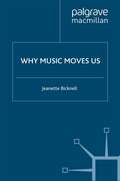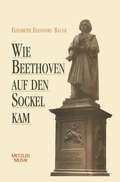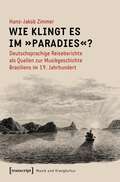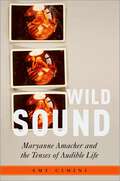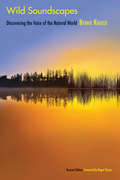- Table View
- List View
Why Music Matters
by David HesmondhalghListen to David Hesmondhalgh discuss the arguments at the core of 'Why Music Matters' with Laurie Taylor on BBC Radio 4's Thinking Allowed here. In what ways might music enrich the lives of people and of societies? What prevents it from doing so? Why Music Matters explores the role of music in our lives, and investigates the social and political significance of music in modern societies. First book of its kind to explore music through a variety of theories and approaches and unite these theories using one authoritative voice Combines a broad yet theoretically sophisticated approach to music and society with real clarity and accessibility A historically and sociologically informed understanding of music in relation to questions of social power and inequality By drawing on both popular and academic talk about a range of musical forms and practices, readers will engage with a wide musical terrain and a wealth of case studies
Why Music Matters
by David HesmondhalghListen to David Hesmondhalgh discuss the arguments at the core of 'Why Music Matters' with Laurie Taylor on BBC Radio 4's Thinking Allowed here. In what ways might music enrich the lives of people and of societies? What prevents it from doing so? Why Music Matters explores the role of music in our lives, and investigates the social and political significance of music in modern societies. First book of its kind to explore music through a variety of theories and approaches and unite these theories using one authoritative voice Combines a broad yet theoretically sophisticated approach to music and society with real clarity and accessibility A historically and sociologically informed understanding of music in relation to questions of social power and inequality By drawing on both popular and academic talk about a range of musical forms and practices, readers will engage with a wide musical terrain and a wealth of case studies
Why Music Moves Us
by J. BicknellMusic has extraordinary power to move us, but how and why does it affect us? What is going on, emotionally, physically and cognitively when listeners have strong emotional responses to music? This is a highly readable, original and philosophically important book for anyone who has ever been moved by music.
Why Patti Smith Matters
by Caryn RosePatti Smith arrived in New York City at the end of the Age of Aquarius in search of work and purpose. What she found - what she fostered - was a cultural revolution. Through her poetry, her songs, her unapologetic vocal power, and her very presence as a woman fronting a rock band, she kicked open a door that countless others walked through. No other musician has better embodied the "nothing-to-hide" rawness of punk, nor has any other done more to nurture a place in society for misfits of every stripe.Why Patti Smith Matters is the first book about the iconic artist written by a woman. The veteran music journalist Caryn Rose contextualizes Smith's creative work, her influence, and her wide-ranging and still- evolving impact on rock and roll, visual art, and the written word. Rose goes deep into Smith's oeuvre, from her first album, Horses, to acclaimed memoirs operating at a surprising remove from her music. The portrait of a ceaseless inventor, Why Patti Smith Matters rescues punk's poet laureate from "strong woman" clichés. Of course Smith is strong. She is also a nuanced thinker. A maker of beautiful and challenging things. A transformative artist who has not simply entertained but also empowered millions.
Why Solange Matters (Music Matters Ser.)
by Stephanie PhillipsThe dramatic story of Solange: a musician and artist whose unconventional journey to international success was far more important than her family name.'Why Solange Matters is a significant and sober treatise on popular music . . . This book is more than necessary.'THURSTON MOOREGrowing up in the shadow of her superstar sister, Beyoncé, and defying an industry that attempted to bend her to its rigid image of a Black woman, Solange Knowles has become a pivotal musician and artist in her own right.In Why Solange Matters, Stephanie Phillips chronicles the creative journey of Solange, a beloved voice of the Black Lives Matter generation. A Black feminist punk musician herself, Phillips addresses not only the unpredictable trajectory of Solange's career but also how she and other Black women see themselves through the musician's repertoire. First, she traces Solange's progress through an inflexible industry, charting the artist's development up to 2016, when the release of her third album, A Seat at the Table, redefined her career. With this record and, then, When I Get Home (2019), Phillips describes how Solange has embraced activism, anger, Black womanhood and intergenerational trauma to inform her remarkable art.Why Solange Matters not only cements the subject in the pantheon of world-changing twenty-first-century musicians, it introduces its writer as an important new voice.
Why the Amish Sing: Songs of Solidarity and Identity (Young Center Books in Anabaptist and Pietist Studies)
by D. Rose ElderSinging occurs in nearly every setting of Amish life. It is a sanctioned pleasure that frames all Amish rituals and one that enlivens and sanctifies both routine and special events, from household chores, road trips by buggy, and family prayer to baptisms, youth group gatherings, weddings, and "single girl" sings. But because Amish worship is performed in private homes instead of public churches, few outsiders get the chance to hear Amish people sing. Amish music also remains largely unexplored in the field of ethnomusicology. In Why the Amish Sing, D. Rose Elder introduces readers to the ways that Amish music both reinforces and advances spiritual life, delving deep into the Ausbund, the oldest hymnal in continuous use. This illuminating ethnomusicological study demonstrates how Amish groups in Wayne and Holmes Counties, Ohio—the largest concentration of Amish in the world—sing to praise God and, at the same time, remind themselves of their 450-year history of devotion. Singing instructs Amish children in community ways and unites the group through common participation. As they sing in unison to the weighty words of their ancestors, the Amish confirm their love and support for the community. Their singing delineates their common journey—a journey that demands separation from the world and yielding to God's will.By making school visits, attending worship services and youth sings, and visiting private homes, Elder has been given the rare opportunity to listen to Amish singing in its natural social and familial context. She combines one-on-one interviews with detailed observations of how song provides a window into Amish cultural beliefs, values, and norms.
Why the Amish Sing: Songs of Solidarity and Identity (Young Center Books in Anabaptist and Pietist Studies)
by D. Rose ElderSinging occurs in nearly every setting of Amish life. It is a sanctioned pleasure that frames all Amish rituals and one that enlivens and sanctifies both routine and special events, from household chores, road trips by buggy, and family prayer to baptisms, youth group gatherings, weddings, and "single girl" sings. But because Amish worship is performed in private homes instead of public churches, few outsiders get the chance to hear Amish people sing. Amish music also remains largely unexplored in the field of ethnomusicology. In Why the Amish Sing, D. Rose Elder introduces readers to the ways that Amish music both reinforces and advances spiritual life, delving deep into the Ausbund, the oldest hymnal in continuous use. This illuminating ethnomusicological study demonstrates how Amish groups in Wayne and Holmes Counties, Ohio�the largest concentration of Amish in the world�sing to praise God and, at the same time, remind themselves of their 450-year history of devotion. Singing instructs Amish children in community ways and unites the group through common participation. As they sing in unison to the weighty words of their ancestors, the Amish confirm their love and support for the community. Their singing delineates their common journey�a journey that demands separation from the world and yielding to God's will.By making school visits, attending worship services and youth sings, and visiting private homes, Elder has been given the rare opportunity to listen to Amish singing in its natural social and familial context. She combines one-on-one interviews with detailed observations of how song provides a window into Amish cultural beliefs, values, and norms.
Why We Love Music: From Mozart to Metallica - The Emotional Power of Beautiful Sounds
by Dr John PowellDid you know that . . .carrying a musical instrument makes you more attractive?music can cure insomnia?music can change the taste of wine?the Mozart effect has nothing to do with Mozart?Barry Manilow songs can be used for crowd control?Why does music affect you so profoundly? It impacts the way you think, talk, feel, behave and even spend money. With his conversational style, humour, and endless knowledge, scientist and musician John Powell showcases fascinating studies - for example that shoppers spend more money in stores that play classical music and, even more astounding, they are more likely to buy German wine in stores playing German music. With chapters on music and emotions, music as medicine, music and intelligence, and much more, Why We Love Music will entertain through to the very last page. A delightful journey through the psychology and science of music, Why We Love Music is the perfect book for anyone who loves a tune.
Why We Sing
by Julia Hollander'A must-read for anyone moved by the power of song' - Lesley Garrett, CBESinging has always been there for us, at the root of what it is to be a human being. Through personal anecdote and scientific fact-finding, this book celebrates the way song inspires and heals us, from the cradle to the grave, and in the process does for singing what The Well-Gardened Mind did for nature, and what Why We Eat did for our diets.As a singing therapist, teacher and performer, Julia Hollander is in a unique position to consider singing's importance to our wellbeing, charting its extraordinary influence on all aspects of our spiritual, emotional and physical lives. Why do parents feel compelled to sing to their newborns, and how does it help their development? What is it about song that brings communities together in harmony but also in protest? How come an activity that helps to embed languages and maths formulae can also be used to rehabilitate Long Covid sufferers? And what magic is at work when people who have lost the power to speak are still able to sing? By delving into her own life experiences, and calling on those of her fellow singers, the author seeks to answer these questions, underpinning her findings with the latest scientific research.In so many walks of life, people of all ages and backgrounds are waking up to the joys of singing, its power to give hope and connection in a fragmented world. Song-making is available in an increasingly broad range of social and therapeutic contexts, prescribed by doctors and community services. This book offers explanations for why this should be, and inspiration to anyone who loves to sing.
Why You Hear What You Hear: An Experiential Approach to Sound, Music, and Psychoacoustics
by Eric J. HellerWhy You Hear What You Hear is the first book on the physics of sound for the nonspecialist to empower readers with a hands-on, ears-open approach that includes production, analysis, and perception of sound. The book makes possible a deep intuitive understanding of many aspects of sound, as opposed to the usual approach of mere description. This goal is aided by hundreds of original illustrations and examples, many of which the reader can reproduce and adjust using the same tools used by the author (e.g., very accessible applets for PC and Mac, and interactive web-based examples, simulations, and analysis tools will be found on the book's website: whyyouhearwhatyouhear.com.) Readers are positioned to build intuition by participating in discovery. This truly progressive introduction to sound engages and informs amateur and professional musicians, performers, teachers, sound engineers, students of many stripes, and indeed anyone interested in the auditory world. The book does not hesitate to follow entertaining and sometimes controversial side trips into the history and world of acoustics, reinforcing key concepts. You will discover how musical instruments really work, how pitch is perceived, and how sound can be amplified with no external power source. Sound is key to our lives, and is the most accessible portal to the vibratory universe. This book takes you there. The first book on sound to offer interactive tools, building conceptual understanding via an experiential approach Supplementary website (http://www.whyyouhearwhatyouhear.com) will provide Java, MAX, and other free, multiplatform, interactive graphical and sound applets Extensive selection of original exercises available on the web with solutions Nearly 400 full-color illustrations, many of simulations that students can do
Why You Hear What You Hear: An Experiential Approach to Sound, Music, and Psychoacoustics
by Eric J. HellerWhy You Hear What You Hear is the first book on the physics of sound for the nonspecialist to empower readers with a hands-on, ears-open approach that includes production, analysis, and perception of sound. The book makes possible a deep intuitive understanding of many aspects of sound, as opposed to the usual approach of mere description. This goal is aided by hundreds of original illustrations and examples, many of which the reader can reproduce and adjust using the same tools used by the author (e.g., very accessible applets for PC and Mac, and interactive web-based examples, simulations, and analysis tools will be found on the book's website: whyyouhearwhatyouhear.com.) Readers are positioned to build intuition by participating in discovery. This truly progressive introduction to sound engages and informs amateur and professional musicians, performers, teachers, sound engineers, students of many stripes, and indeed anyone interested in the auditory world. The book does not hesitate to follow entertaining and sometimes controversial side trips into the history and world of acoustics, reinforcing key concepts. You will discover how musical instruments really work, how pitch is perceived, and how sound can be amplified with no external power source. Sound is key to our lives, and is the most accessible portal to the vibratory universe. This book takes you there. The first book on sound to offer interactive tools, building conceptual understanding via an experiential approach Supplementary website (http://www.whyyouhearwhatyouhear.com) will provide Java, MAX, and other free, multiplatform, interactive graphical and sound applets Extensive selection of original exercises available on the web with solutions Nearly 400 full-color illustrations, many of simulations that students can do
The Wichita Lineman: Searching in the Sun for the World's Greatest Unfinished Song
by Dylan Jones'It's just another song to me. I've written 1,000 of them and it's really just another one.' Jimmy Webb 'When I heard it I cried. It made me cry because I was homesick. It's just a masterfully written song.' Glen CampbellThe sound of 'Wichita Lineman' was the sound of ecstatic solitude, but then its hero was the quintessential loner. What a great metaphor he was: a man who needed a woman more than he actually wanted her. Written in 1968 by Jimmy Webb, 'Wichita Lineman' is the first philosophical country song: a heartbreaking torch ballad still celebrated for its mercurial songwriting genius fifty years later. It was recorded by Glen Campbell in LA with a legendary group of musicians known as 'the Wrecking Crew', and something about the song's enigmatic mood seemed to capture the tensions in America at a moment of crisis. Fusing a dribble of bass, searing strings, tremolo guitar and Campbell's plaintive vocals, Webb's paean to the American West describes a telephone lineman's longing for an absent lover, who he hears 'singing in the wire' - and like all good love songs, it's an SOS from the heart. Mixing close-listening, interviews and travelogue, Dylan Jones explores the legacy of a record that has entertained and haunted millions for over half a century. What is it about this song that continues to seduce listeners, and how did the parallel stories of Campbell and Webb - songwriters and recording artists from different ends of the spectrum - unfold in the decades following? Part biography, part work of musicological archaeology, The Wichita Lineman opens a window on to America in the late-twentieth century through the prism of a song that has been covered by myriad artists in the intervening decades.'Americana in the truest sense: evocative and real.' Bob Stanley
The Wickedest
by null Caleb Femi'Atmospheric and intoxicating … The Wickedest is a heady night in the dance' CANDICE CARTY-WILLIAMS Caleb Femi returns with a landmark, life-affirming new poetry collection, The Wickedest. This is a minute-by-minute depiction of a typical night at a legendary monthly house party known as 'The Wickedest'. Here, we meet a vivid cast of characters, young and old, all surfing a revelry steeped in camaraderie, community, desire and a spirit of jubilant defiance. A modern epic, The Wickedest explores the institution of shoobs or house parties and their vital role within working-class communities. The poems range from classical English sonnets to experimental forms and are immersively interwoven with photographs, text messages and ephemera. The collection playfully dissembles parties – in space, sound, law and bureaucracy – to document the precarious existence of our nightlife venues. In Caleb Femi's inimitable, cinematic style the book builds to a crescendo that is at once euphoric and grief-soaked. The Wickedest calls us to cast our minds to the moments we stood surrounded by our loved ones on a dancefloor, arms outstretched, and freed ourselves from the weight of reality to float. 'A joyous, lyrical read' YOMI ADEGOKE 'A near-holy experience' JONATHAN ESCOFFERY 'This is poetry that moves and is felt in the body' ANDREW MCMILLAN
Wie Beethoven auf den Sockel kam: Die Entstehung eines musikalischen Mythos
by Elisabeth Eleonore Bauer»Wie ein Begehren«: Sprache und Musik in der Interpretation von Vokalmusik (nicht nur) des Fin de Siècle (Musik und Klangkultur #28)
by Bartolo MusilSprache und Musik begegnen einander im singenden Körper. Besonders eng verwoben sind sie in Kunstlied und mélodie um 1900: Dies bildet den Ausgangspunkt für eine Systematik von beispielhaften Stimmgebungen zwischen Sprechen und Singen, die einen Bogen von der Theaterdeklamation bis hin zur Vokalise spannen. Bartolo Musil zeigt, wie Komposition und Interpretation, Gesangstechnik und Hermeneutik, Sprachgestaltung und musikalische Phrasierung dabei in einen Dialog eintreten, und erzählt das schillernde und prekäre Miteinander von Wort und Ton in gesungener Kunstmusik neu - als Liebesgeschichte zwischen Hingabe, Verschmelzung, lustvoller Differenz, Abstoßung und Selbstbehauptung.
Wie klingt die globale Ordnung: Die Entstehung eines Marktes für World Music (Musik und Medien)
by Glaucia Peres da SilvaGlaucia Peres da Silva analysiert „World Music“ im Spannungsfeld zwischen Kultur und Markt. Anhand einer kultursoziologisch ansetzenden Marktsoziologie macht die Autorin deutlich, dass die Konstruktion eines Musikgenres eine konstitutive Bedingung für die Entstehung und Stabilisierung eines Musikmarktes ist. Insbesondere wird das Ineinandergreifen von Ästhetik und Markt untersucht. Durch diese Analyse zeigt die Autorin zudem, wie die lokale Herstellung von „World Music“ ihre Globalität möglich macht.
Wie klingt es im »Paradies«?: Deutschsprachige Reiseberichte als Quellen zur Musikgeschichte Brasiliens im 19. Jahrhundert (Musik und Klangkultur #38)
by Hans-Jakob ZimmerReiseberichten eilt in der Musikforschung ein ambivalenter Ruf voraus: Mitunter kategorisch abgelehnt als ernst zu nehmende Quellen, bergen sie gleichwohl häufig einzigartige Informationen zur musikalischen Frühgeschichte von Ethnien und Ländern. Darüber hinaus erweisen sie sich als wertvolle mentalitätsgeschichtliche Dokumente ihrer Autor_innen. Hans-Jakob Zimmer unternimmt die bislang umfangreichste Auswertung deutschsprachiger Reiseberichte im Hinblick auf das Musikleben des Landes Brasilien, welches nach der Umsiedlung des portugiesischen Königshofs nach Rio de Janeiro im Jahr 1808 zu einem Sehnsuchtsort für Naturforscher, Reisende und Auswanderer avancierte.
Wiederholung als zentrales universelles Gestaltungsmittel der Musik (Zeitgenössische Musikwissenschaft)
by Ulli GötteIm Zentrum des Buches steht die Betrachtung der Wiederholung in ihren vielfältigen, kulturübergreifenden Erscheinungsformen. Zahlreiche Analysen aus den Bereichen der abendländischen Kunstmusik, der europäischen Volksmusik, der afrikanischen, indonesischen und indischen Musik sowie der populären Musik untermauern die einzigartige Bedeutung der Wiederholung als musikalisches Gestaltungsmittel. Die europäische Theorie der musikalischen Form, mathematische Betrachtungen, Minimal Music (als Inbegriff repetitiver Musik) sowie ästhetische Überlegungen werden in einzelnen Kapiteln behandelt. Eine Systematisierung der Wiederholungsstrukturen steht am Ende des Buches. Entsprechend dieser Bedeutung wird die Schrift eingeleitet mit einer streifzugartigen Darstellung der Wiederholung als einer universellen, kunstspartenübergreifenden Strategie.
Wiegen-und Kinderlieder: Gesammelt durch die Brüder Grimm
by Heinz Rölleke Jacob und GrimmEine aufsehenerregende Trouvaille: Zum ersten Mal werden die von den Brüdern Grimm zwischen 1807 und 1830 gesammelten Wiegen- und Kinderlieder in einer umfassend kommentierten, mit zeitgenössischen Illustrationen ausgestatteten Ausgabe der Öffentlichkeit zugänglich gemacht.
Wild colonial boys: A Belfast punk story
by Thomas Paul BurgessRuefrex were one of Northern Ireland’s most popular and uncompromising punk rock bands.Emerging from the Belfast street-gang culture of the late-1970s, the group, inspired by The Clash, enjoyed a turbulent, decade-long career. They played for millions on CNN and Channel 4, toured with The Pogues and recorded the controversial ‘The Wild Colonial Boy’, which attacked American donations to Northern Irish terrorist organisations.Throughout it all, founder member, songwriter and spokesperson Thomas Paul Burgess ensured the band remained faithful to their Protestant, working-class origins. This candid memoir takes us on a journey from the streets of Belfast to encounters with U2, Shane MacGowan, The Cure, The Fall and Seamus Heaney.From strife-torn 1970s Belfast to bohemian London, Wild colonial boys tells the story of a punk band who refused to give up and stayed true to their punk roots.
Wild colonial boys: A Belfast punk story
by Thomas Paul BurgessRuefrex were one of Northern Ireland’s most popular and uncompromising punk rock bands.Emerging from the Belfast street-gang culture of the late-1970s, the group, inspired by The Clash, enjoyed a turbulent, decade-long career. They played for millions on CNN and Channel 4, toured with The Pogues and recorded the controversial ‘The Wild Colonial Boy’, which attacked American donations to Northern Irish terrorist organisations.Throughout it all, founder member, songwriter and spokesperson Thomas Paul Burgess ensured the band remained faithful to their Protestant, working-class origins. This candid memoir takes us on a journey from the streets of Belfast to encounters with U2, Shane MacGowan, The Cure, The Fall and Seamus Heaney.From strife-torn 1970s Belfast to bohemian London, Wild colonial boys tells the story of a punk band who refused to give up and stayed true to their punk roots.
Wild Sound: Maryanne Amacher and the Tenses of Audible Life (Critical Conjunctures in Music and Sound)
by Amy Cimini"We haven't even made it to breakfast!" was a phrase often used by composer Maryanne Amacher (1938-2009) to shorthand her critical and partial approach to knowledge production across the vast artistic, technical, and scientific discourses with which she worked. The same could be said about her own musical thought, which encompassed original presentational formats in existing and speculative media and approaches to sound and listening that conjoined real and imagined social worlds. Wild Sound: Maryanne Amacher and the Tenses of Audible Life discerns meeting points between frameworks for life that emerged from Amacher's multidisciplinary study of sound and listening: within acoustical spectra, inside human bodies and ears, across cities and edgleands, hypothetical creatures and virtual, fictive or distanciated environments. These figurations guide interpretative study of six signal projects: Adjacencies (1965/1966); City-Links (1967-1988); Additional Tones (1976 / 1988), Music for Sound-Joined Rooms (1980), Mini Sound Series (1985) and Intelligent Life (1980s) and countless sketches, notes and unrealized projects. Author Amy Cimini explores Amacher's working methods with an interpretive style that emphasizes technical study, conceptual juxtaposition, intertextual play, and narrative transport.
Wild Sound: Maryanne Amacher and the Tenses of Audible Life (Critical Conjunctures in Music and Sound)
by Amy Cimini"We haven't even made it to breakfast!" was a phrase often used by composer Maryanne Amacher (1938-2009) to shorthand her critical and partial approach to knowledge production across the vast artistic, technical, and scientific discourses with which she worked. The same could be said about her own musical thought, which encompassed original presentational formats in existing and speculative media and approaches to sound and listening that conjoined real and imagined social worlds. Wild Sound: Maryanne Amacher and the Tenses of Audible Life discerns meeting points between frameworks for life that emerged from Amacher's multidisciplinary study of sound and listening: within acoustical spectra, inside human bodies and ears, across cities and edgleands, hypothetical creatures and virtual, fictive or distanciated environments. These figurations guide interpretative study of six signal projects: Adjacencies (1965/1966); City-Links (1967-1988); Additional Tones (1976 / 1988), Music for Sound-Joined Rooms (1980), Mini Sound Series (1985) and Intelligent Life (1980s) and countless sketches, notes and unrealized projects. Author Amy Cimini explores Amacher's working methods with an interpretive style that emphasizes technical study, conceptual juxtaposition, intertextual play, and narrative transport.
Wild Soundscapes: Discovering the Voice of the Natural World, Revised Edition (The\future Ser.)
by Bernie KrauseThrough his organization Wild Sanctuary, Bernie Krause has traveled the globe to hear and record the sounds of diverse natural habitats. Wild Soundscapes, first published in 2002, inspires readers to follow in Krause’s footsteps. The book enchantingly shows how to find creature symphonies (or, as Krause calls them, “biophonies”); use simple microphones to hear more; and record, mix, and create new expressions with the gathered sounds. After reading this book, readers will feel compelled to investigate a wide range of habitats and animal sounds, from the conversations of birds and howling sand dunes to singing anthills. This rewritten and updated edition explains the newest technological advances and research, encouraging readers to understand the earth’s soundscapes in ways previously unimaginable. With links to the sounds that are discussed in the text, this accessible and engaging guide to natural soundscapes will captivate amateur naturalists, field recordists, musicians, and anyone else who wants to fully appreciate the sounds of our natural world.
The Wild Tchoupitoulas’ The Wild Tchoupitoulas (33 1/3)
by Bryan WagnerThe Wild Tchoupitoulas is a definitive expression of the modern New Orleans sound. From "Hey Pocky A-Way" to "Big Chief Got a Golden Crown," the album draws on carnival traditions stretching back a century, adapting songs from the Mardi Gras Indians. Music chanted in the streets with tambourines and makeshift percussion is transformed throughout the album into electric rhythm and blues accented funk, calypso, and reggae. The album bridges not only genres but generations, linking the improvised flow from group leader George Landry, better known as Big Chief Jolly, to the stacked harmony vocals by his nephews Aaron, Art, Charles, and Cyril--the core members of the soon-to-be-formed Neville Brothers, playing together here for the first time.With production from Allen Toussaint and support from The Meters, the city's preeminent funk ensemble, The Wild Tchoupitoulas brings an all-star brigade, pressing these old anthems into new arrangements that have since become carnival standards. In the process, the album helped to establish the terms by which processional second-line music in New Orleans would be commercialized through the record industry and the tourist trade, setting into motion a process that has raised more questions than it has answered about autonomy, authenticity, and appropriation under the conditions of a new cultural economy.

